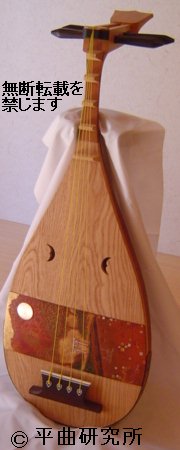A stringed instrument originating in western Asia before the birth of Christ traveled west to become the lute,
and east to become the Chinese pipa and the Japanese biwa.
A number of different types of biwa exist in Japan, all of different age and transmitted along different routes.
The tradition of heike biwa, born in the 13th century, is the Heike monogatari,
the tale of the late 12th-century war between the Minamoto and the Taira clans,
chanted to the accompaniment of the biwa.
Incorporating elements of Buddhist vocal music, the voice part of heike biwa employs an extremely wide pitch range as well as a great variety of narrative styles,
from recitation to song. The biwa is played extensively in sections of transition between the narrative styles.
This music became a fundamental source of later vocal forms, such as the music of the noh and kabuki theatres.
The heike biwa tradition was passed down mainly by blind musicians of the upper classes,
but from the 17th century it was also cultivated by sighted literati.
For them, learning to chant the Heike monogatari meant studying music, history, Chinese historical anecdotes, poetry,
and military tactics all at the same time.
Copyright:SUZUKI Madoka / Nov.23.2000

sound230KB
| SUZUKI Madoka
Transmitter Heike-biwa Tradition  |